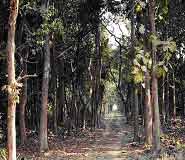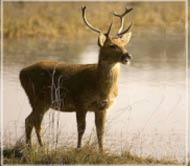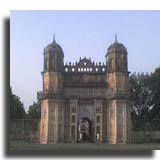INTRODUCTION
The Dudhwa National Park lies on the India Nepal border in the foothills of Himalaya and the plains of Terrai.This park existed since 1879 and got the status of National Park in 1977.Only eleven years later after the addition of Kishanpur Sanctuary Dudhwa became a part of Project Tiger. The Dudhwa National park sprawls over an area of about 614 sq. Km and the park is noted for its diverse and productive tarai eco-systems. The Dudhwa National Park is home to a diverse population of wildlife with one of the apt terrain ranging from mosaic grasslands to dense sal forests and swampy marshes. Though the population of tiger in Dudhwa is numerous it is very difficult to spot out because of the dense nature of the forest. The other wildlife population here includes Leopards, Hispid Hares, Swamp Deer (Barasingha) and Rhinos thrive amidst the vegetation.LOCATION

BEST TIME TO VISIT
The ideal time to visit the Dudhwa National Park is between the months of November to May and it remains closed from July to October.ATTRACTION
FLORA
The predominant vegetation or the flora of the Dudhwa National Park are tropical semi-evergreen forest, tropical moist deciduous forest, riparian and swamp forest and dry deciduous forest. The forest also harbours different tree species like Shorea robusta, Terminalis tomentosa, Adina cordifolia, Terminalia belerica, Eugenia jambolana, Dalbergia sissoo, and Bombax malabaricum.The mesophyllous grasslands called as the phantas can be seen in wide stretches throughout the entire area of the Dudhwa National Park.FAUNA

AVIAN
The avian population in Dudhwa includes both native and migratory birds and is a major delight for avid bird watcher. It includes nearly 400 species of birds like Swamp Partridge, Great Slaty Woodpecker, Bengal Florican, plenty of painted storks, sarus cranes, owls, barbets, woodpeckers, minivets and many more. Much of the park�s avian fauna is aquatic in nature, and is found around Dudhwa�s lakes- especially Banke Tal.The avian species of Dudhwa National park also includes a range of owls like the great Indian horned owl, the brown fish owl, the dusky horned owl, scoops owl, jungle owlet, the brown wood owl and tawny fish owl.REPTILES
The short nosed crocodile - the mugger and otters can be seen along the river banks as well as pythons and monitor lizards.OTHER ATTRACTION
FROG TEMPLE
The en route to Dudhwa leads to a place called Oyal which is noted for its unique frog temple. This temple is located in the Lakhimpur-Kheri district whose presiding deity is Lord Shiva. This stone temple is the only one of its kind in India which is built in the shape of a frog by the Maharajas of the Oyal state.SURAT BHAWAN PALACE

ACCOMMODATIONThe Forest Department of the Dudhwa National Park has set up various rest houses within the park.
EAT OUTS AND PRIVATE ACCOMMODATIONApart for the accommodation arranged by the Forest department there are number of middle range private hotels at nearest town Palia.
|
Travel Guide
Travel Information
| |||||||||||||||||||||||||||||||||||||||
GETTING THERE>
BY AIR
Lucknow is the closest airport.Indian Airlines operates a number of flights to Lucknow from major cities across the country. Air Sahara flies from Mumbai to Lucknow everyday.The next closest airport outside India is Nepal at a distance of 35 kms from Dudhwa.
BY ROAD
UPSRTC and private bus services link Palia to Lakhimpur Kheri, Shahjahanpur, Bareilly, Delhi etc. Buses ply frequently between Palia and Dudhwa.
BY RAIL
The nearest railheads are Dudhwa (4 kms), Palia (10 kms) and Mailani (37 kms), however the most convenient way would be to travel to Lucknow and hit the road or take a train to any of the nearer stations from there. Some of the important daily trains from Delhi to Lucknow are Kaifiyat Exp.,Lucknow Mail,Shramjeni N Exp.,Vaishali Exp.
- Send your feedback / Change Request by using this link.
- List your Hotel / Travel Agency with Photos in this web page .



